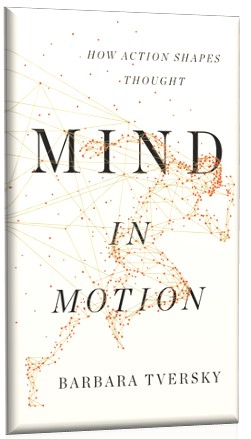BNA Annual General Meeting 2025
1st April 2025
12th Mar 2020
Barbara Tversky (New York: Basic Books, 2019.)
 Upon reading the phrase ‘How action shapes thought’, an initial reaction might be to question this thesis: ‘Does it?’ Tversky argues that it does, laying out her premise that spatial thinking underlies everything, and especially, the structure and meaning of language. In colloquial prose, she guides the reader through a vast area of research that substantiates the dust jacket’s claim that the work is ground-breaking.
Upon reading the phrase ‘How action shapes thought’, an initial reaction might be to question this thesis: ‘Does it?’ Tversky argues that it does, laying out her premise that spatial thinking underlies everything, and especially, the structure and meaning of language. In colloquial prose, she guides the reader through a vast area of research that substantiates the dust jacket’s claim that the work is ground-breaking.
Her intended audience is wide and includes neuroscientists, biologists, chemists, computer scientists, linguists, and educators as well as other interest groups such as those involved in art and design, museums or engineering. The book should appeal particularly to the latter group due to its accessible, conversational style, interweaving theory with myriad examples ranging from the everyday to space and time, nature and the design of the world.
Yet, however delightful it may be, Tversky’s style of writing might well frustrate professional neuroscientists more used to a concise form of language. In part, this is due to the text’s accumulation of so many relevant examples, often rhythmically tumbling over the page that tend to impede more than illustrate the reader’s grasp of the concept. Also, when it comes to a description of the Homunculus on pages 11 and 12, compared to a more scientific description in Fundamentals of Cognitive Neuroscience. A beginner’s Guide. Gage & Baars, p.37, the reader might well be forgiven for wondering the actual level of readership envisaged by the author:
‘Before that, we map our bodies onto our brains, onto the homunculus, the “little man”, sprawled ear-to-ear across the top shell, the cortex, of our brains.’ p.11
‘The homunculi are strange little people, with oversized heads, huge tongues, enormous hands, and skinny torsos and limbs.’ p.12
‘The motor homunculus. The motor cortex is structured with a ‘map’ of the body: this is referred to as the homunculus (“little man”) as it contains all parts of the body. The representation of differing body parts in the motor cortex is not proportional to those body parts; however, some areas of the body – such as the face, mouth, and hands – have a proportionately larger representation in the motor cortex than other body areas such as the back and trunk of the body.’
Such contrast, although annoying at times, does not prevent the enjoyment and interest that comes from exploring this book with its sudden surprises and unusual facts that stimulate thought.
Tversky is a leading psychologist from New York City and California, an emerita professor at Teachers College at Columbia University, a prolific author of scholarly articles and has many global invitations to speak about embodied cognition at interdisciplinary workshops and conferences. She is obviously well-read in many subjects and the style of this book manifests a teacher at heart, for it is open-ended in appeal and delineates a thoughtful insight into spatial thinking as the body engages with the environment. The premise set out on page 3 – ‘spatial thinking, rooted in perception of space and action in it, as the foundation for all thought’ – is declared by the author as ‘audacious’. It includes insightful scientific data, literary, philosophical or artists’ quotations, photographs, diagrams, drawings, cartoons, a good index and fifty-five pages of clear, detailed bibliographic notes.
After a short introductory chapter, the volume is divided into two parts:
‘The World in the Mind’ in four chapters considers: the insider’s view of body space shaped by actions and sensations, the outsider’s view shaped by appearance and the role of mirror neurons; how we recognise, categorize, understand and differentiate aspects of the environment, but also need to think harder about its dimensions and shared features across categories, faces and emotions; an examination of how the body’s space and navigational space are represented in the brain, thus supporting the premise of the book; the transforming of thought, distinguishing representations from transformations followed by analysis and use of special transformations; and lastly, how to overcome the quandary of spatial abilities.
‘The Mind in the World’, over six chapters examines: how the body can speak its own language by means of gestures that relate to thought and interaction with others, the role of music and other arts including design; a matter of perspective and how linear language describes space inside or outside the body; a reflection on all geometric forms and how they capture thoughts about all aspects of space, time, number, order, boundaries, perspective and causality, with a summary on Language and Space/Thinking and Thought; created spaces and a discussion regarding maps, diagrams, sketches, explanations and comics; science and art – drawing without words involving eyes, hands or marks, in order to see, clarify and create; consideration as to whether the mind is the key to creativity; goals of the two general cognitive design principles: correspondence and use.
Finally, in Chapter 10, Tversky concludes by stating that our actions have redesigned both ourselves and the world of today; a world seen as a diagram designed as a spiral rising out of our own creativity; a world that speaks a spatial language enhancing not only us but also our technology and horizons.
Integrated within these two parts are Tversky’s own Nine Laws of Cognition placed within chapters to highlight the key cognitive points of interest within the book, that no doubt would help revision for those new to the subject.
In an earlier review, Constantine Sandis claims that Tversky ‘holds back from embracing the stance of her closest philosophical allies who champion 4E Cognition’. This refers to current thinking in the thriving field of interdisciplinary research where embodied, embedded, enactive, and extended presupposes cognition as being shaped and structured by dynamic interactions between the brain, body, and both the physical and social environments. You may or may not agree, but no matter what your own experience or field of interest, Mind in Motion remains a fascinating book that tempts the reader to browse at leisure.
Brenda Walker PhD, Loughborough
Image of homunculus: Dr. Joe Kiff (http://psychology.wikia.com/wiki/User:Lifeartist / http://psychology.wikia.com/wiki/User:Dr_Joe_Kiff) / CC BY-SA (https://creativecommons.org/licenses/by-sa/3.0)

Brenda has been an associate member of the BNA for 2 years.
‘Having left school at sixteen, my varied careers had been in the arts and education, so apart from a School Certificate in Biology in 1950, a general interest in health while bringing up 5 children under 7, and my work as a teacher of all age groups, I had no knowledge of neuroscience.’
Recently, an unexplained (though thankfully not serious) blackout led her, out of curiosity, to explore the brain and nervous system online, and eventually to contact the BNA. ‘Trying to sort out and over-learn the terminology and functions was extremely difficult, but I did manage to prove to myself that at 83 I wasn’t too old to learn a new subject.’
In 2013, after many years of hoping to be able to work on a doctorate, Brenda achieved her PhD from the University of Loughborough in the field of Creative Writing, aged 79. Having had a procedure to replace an aortic valve while studying for her PhD, Brenda is now a patient advocate for the charity ‘HeartValveVoice’. She has spoken on the radio and at conferences; given interviews; written papers; spoken at the European Parliament in Brussels and for the Medical Technology Group at the House of Commons, to spread awareness of heart valve disease.
The BNA is grateful to Brenda for writing this book review and invites any BNA members to write to us at office@bna.org.uk with a neuroscience-related book they would like to review.